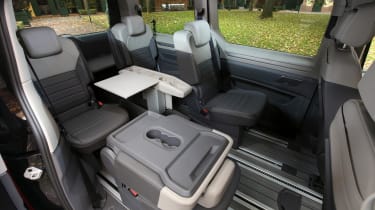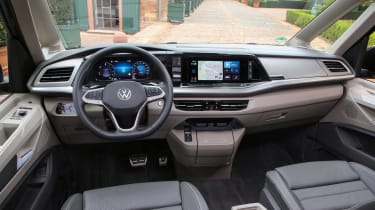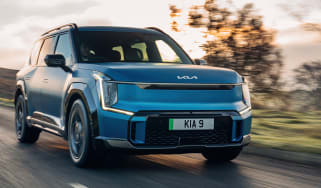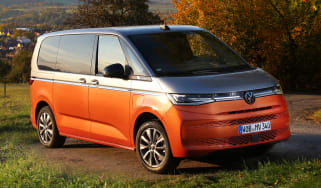Volkswagen Multivan eHybrid review
The latest generation of Volkswagen's iconic minibus now sits on a passenger-car platform and offers plug-in hybrid power
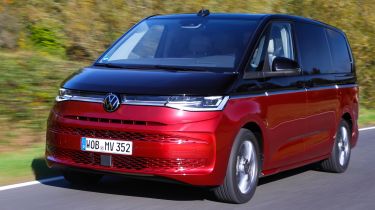
Pros
- Handsome looks
- Very practical and versatile
- Smooth ride and decent handling
Cons
- Pretty expensive
- No eight or nine-seat option
- Infotainment system niggles
| Car type | Electric range | Fuel economy | CO2 emissions |
|---|---|---|---|
| Plug-in hybrid | 30-32 miles | 157mpg | 41g/km |
The vehicle UK buyers have known for years as the Volkswagen Caravelle can trace its roots back to the iconic 'split-screen' Type 2 van of the 1950s. Now, for the first time in the model's history, the passenger-carrying version isn't based on the same underpinnings as the cargo model.
The current Volkswagen Transporter van (known as the T6) is set to continue on sale for some time, before being replaced by a sister model of the next-generation Ford Transit Custom. For the T7 generation of the passenger version, however, there's wholesale change. Firstly, it's based on the same 'MQB' platform that underpins many of VW's current passenger cars, including the Golf and Passat. Secondly, the Caravelle name has been retired in the UK, in favour of the Multivan moniker that has long been used in Europe.
Thirdly – and perhaps most significantly – you can now buy a Multivan 'eHybrid' plug-in version, fitted with the German brand's familiar 1.4-litre eTSI petrol-electric hybrid engine. Here, it makes 215bhp, falling between the 201bhp of the Golf eHybrid and the 242bhp of the sporty Golf GTE. That's sufficient for a 0-62mph time of 11.6 seconds – adequate but hardly punchy. The petrol engine is noisy, too, and the electric motor does a lot of the work when accelerating up hills or dealing with a heavy load, so you'll want to be driving with plenty of charge in the battery as much as possible.
The Multivan is 1.94 metres wide and 1.9 metres high, while two different body lengths (4.97 and 5.17 metres) are offered. There's a wide and varied engine range, including 1.5 and 2.0-litre TSI petrols, two flavours of 2.0-litre TDI diesel and the plug-in hybrid setup we're concentrating on in this review.
On the practicality front, sliding doors on both sides are standard, as is a seven-seat setup, with two seats in the second row and three in the third. The middle pair can be rotated 180 degrees for a conference-style layout, while a multifunction table on tracks can be moved to any row. The seats themselves are easier to adjust and remove than before, partly thanks to weighing 25% less than those in the previous model.
The more utilitarian eight or nine-seater layouts available with the Caravelle are not on offer this time around. Cargo volume can be up to 3,672 litres if you remove both rows of rear seats (4,053 litres with the longer body length), dropping to 1,844 litres if you fit just the second row and 469 litres with all seats in place. There are also plenty of storage bins dotted around the cabin.
Like other Volkswagen models using the 1.4-litre plug-in hybrid powertrain, a six-speed dual-clutch automatic gearbox is standard on the Multivan eHybrid. In addition, its 13kWh battery stores enough power to cover around 30 miles in zero-emissions, fully electric mode. On the road, whether you're running on the electric motor or the engine, smoothness and comfort are the order of the day – although the boxy body shape does give rise to more wind noise than a smaller car would generate at high speeds.
The optional adaptive dampers deliver a more sophisticated driving experience than the old van-based Caravelle could, and the Multivan feels a lot lighter on its feet than its commercial predecessor. The steering is also very light and offers hardly feedback. While that's a downside on a twisty country road, in combination with a tight turning circle it does mean the Volkswagen is very easy to manoeuvre around town. Excellent visibility thanks to extensive glass areas helps in this respect, too.

The Multivan eHybrid is offered in two trims – Life and Style – with prices starting from just over £48,000. The long list of standard equipment includes a 10.25-inch ‘digital cockpit’ driver’s display and 10-inch central infotainment touchscreen with Android Auto and wireless Apple CarPlay, plus LED headlights, sliding rear doors on both sides, 17-inch alloy wheels and safety systems including adaptive cruise control, lane-keeping assistance, a reversing camera and parking sensors at the front and rear.
Upgrading to the Style trim gets you a 14-speaker Harmon Kardon sound system, along with an upgraded digital driver’s display and infotainment setup, a panoramic sunroof, a 360-degree camera, heated front seats, a heated leather steering wheel, stainless-steel pedals and enhanced noise insulation, plus extra safety systems such as parking assistance, rear cross-traffic alerts and VW’s 'Travel Assist', which allows for semi-autonomous driving. Pricing for the range tops out at nearly £60,000.
The Multivan eHybrid's most obvious rival is the Ford Tourneo Custom PHEV, which comes in close to the £50,000 mark, offering a slightly less upmarket finish and image than the Multivan, but seating for up to eight. Hybrid seven-seater SUVs such as the Toyota Highlander, Lexus RX L and Kia Sorento PHEV may also be a consideration, although none will match the sheer versatility and carrying capacity of the Multivan.
